
Earl of Warwick is one of the most prestigious titles in the peerages of the United Kingdom. The title has been created four times in English history, and the name refers to Warwick Castle and the town of Warwick.

Henry de Cobham, 1st Baron Cobham lord of the Manor of Cobham, Kent and of Cooling, both in Kent, was an English peer.

The titles Baron Beauchamp and Viscount Beauchamp have been created several times throughout English and British history. There is an extant Viscountcy of Beauchamp, held by the Seymour family, Marquesses of Hertford.
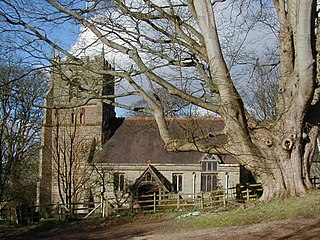
Beoley is a small village and larger civil parish north of Redditch in the Bromsgrove District of Worcestershire. It adjoins Warwickshire to the east. The 2001 census gave a parish population of 945, mostly at Holt End. The parish includes the hamlet of Portway, adjacent to the A435 road. It adjoins the Redditch suburb of Church Hill and the civil parishes of Alvechurch, Tanworth-in-Arden, Mappleborough Green and Wythall.
William Mauduit, 8th Earl of Warwick or William Maudit was an English nobleman and participant in the Second Barons' War.

Elmley Castle is a village and civil parish in Worcestershire, in England, United Kingdom. It is located on the north side of Bredon Hill 3 miles south east of Pershore in the local government district of Wychavon.
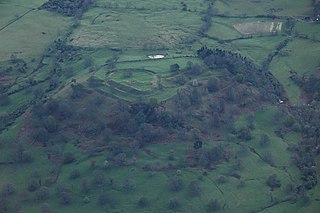
Elmley Castle was a late 11th-century earthwork and timber castle which received stone additions in the 12th and possibly 13th centuries, located 0.5 miles (0.8 km) south of the village of Elmley Castle and 12 miles (19 km) southeast of the city of Worcester, in Worcestershire. Nothing but the earthworks survive.

John Beauchamp, 1st Baron Beauchamp of Powick, KG, was an English nobleman and administrator. He was the son and eventual heir of Sir William Beauchamp of Powick in Worcestershire, Constable of Gloucester Castle, by his wife, Katherine Usflete, daughter and heiress of Sir Gerard de Usflete, a Member of Parliament for Yorkshire in 1401.

Sir John de Beauchamp, 1st Baron Beauchamp of Kidderminster of Holt Castle in Worcestershire was an administrator and landowner.

Roger de Mortimer was a medieval marcher lord, residing at Wigmore Castle in the English county of Herefordshire. He was the son of Hugh de Mortimer and Matilda Le Meschin.
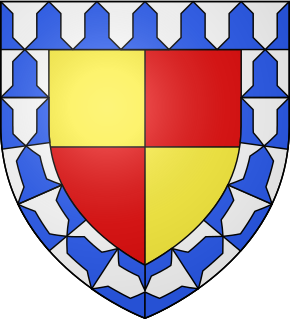
John FitzGeoffrey, Lord of Shere and Justiciar of Ireland was an English nobleman and Crown official.

William de Beauchamp, 9th Earl of Warwick was the eldest of eight children of William de Beauchamp of Elmley and his wife Isabel de Mauduit. He was an English nobleman and soldier, described as a “vigorous and innovative military commander." He was active in the field against the Welsh for many years, and at the end of his life campaigned against the Scots.
Alice de Toeni, Countess of Warwick was a wealthy English heiress and the second wife of Guy de Beauchamp, 10th Earl of Warwick, an English nobleman in the reign of kings Edward I and Edward II. He was one of the principal opponents of Piers Gaveston, a favourite of Edward II. Alice married three times; Guy was her second husband.
Sir Walter Beauchamp was an English lawyer who was Speaker of the House of Commons of England between March and May 1416.
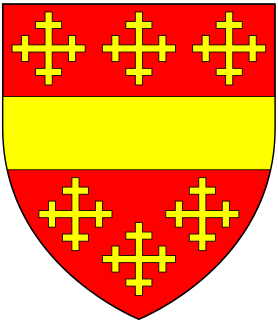
William III de Beauchamp of Elmley Castle in Worcestershire, was an English Baron and hereditary Sheriff of Worcestershire.

Walter II de Beauchamp, of Elmley Castle in Worcestershire, was hereditary Sheriff of Worcestershire.

Adam de Harvington, also called Adam de Herwynton (c.1270-c.1345) was a fourteenth-century Crown official and judge who had a successful career in both England and Ireland. He held office as Chief Baron of the Irish Exchequer and Lord Treasurer of Ireland, and as Chancellor of the Exchequer of England, and acquired considerable wealth as a result.

The Bear and Ragged Staff is a heraldic emblem or badge associated with the Earldom of Warwick.
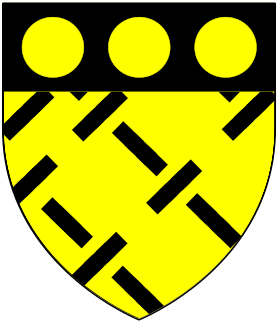
Baron St Amand was a title created twice in the Peerage of England: firstly in 1299 for Amauri de St Amand (1269–1310), who died without issue, when it became extinct; and secondly in 1313 for his brother John de St Amand (1283/6–1330).

















